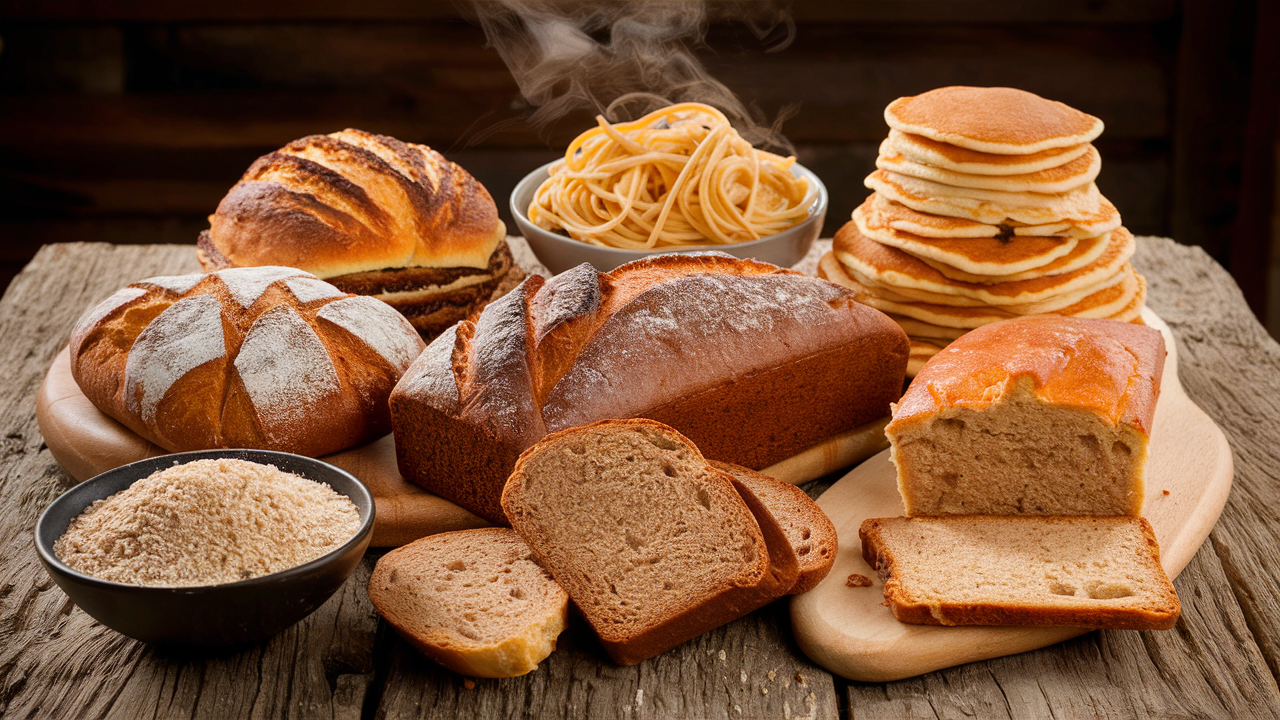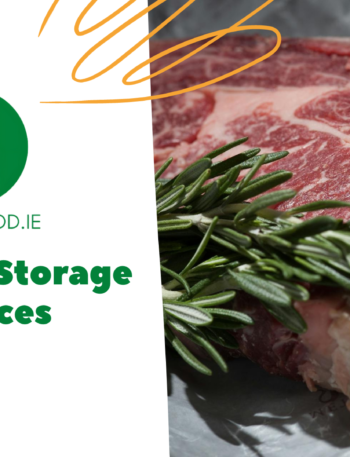Flour, the finely milled powder derived from wheat and other grains, is a fundamental ingredient in baking and cooking. This comprehensive guide explores various types of flour, their unique properties, and optimal uses in the kitchen.
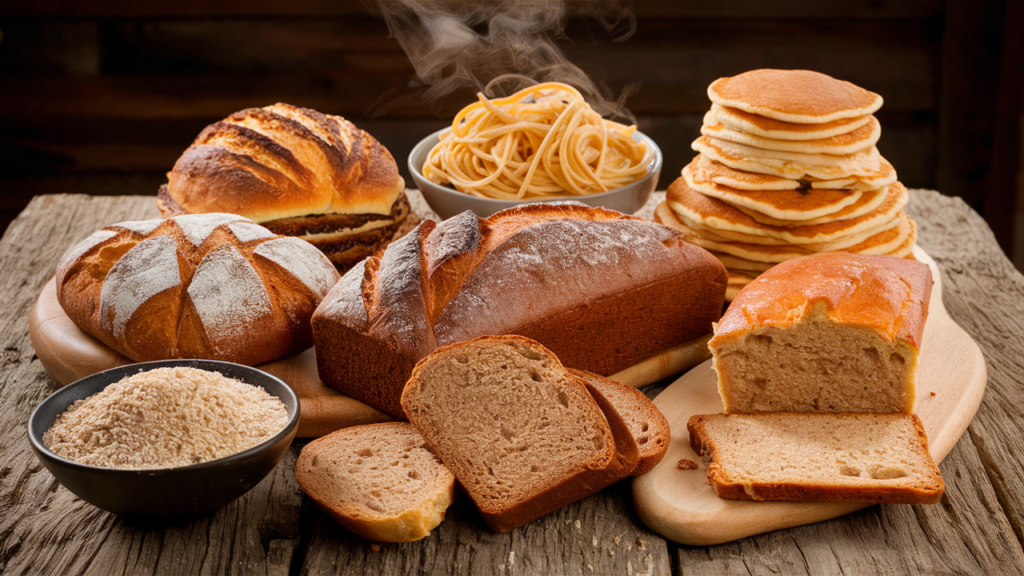
Flour Basics
Flour
- Powder made by grinding raw grains, roots, beans, nuts, or seeds
Primary Uses
- Main ingredient in various foods like bread, a staple food for many cultures
Types
- Includes cereal flour (wheat, corn, rye) and can be categorized as whole-grain or refined flour
Cultural Importance
- Corn flour significant in Mesoamerican cuisine
- Rye flour key in Central and Northern European cuisine
Flour is a versatile powder made by grinding raw grains, seeds, or roots, serving as a fundamental ingredient in numerous cuisines worldwide. Wheat flour, the most common type, is a staple in Oceanic, European, South American, North American, Middle Eastern, North Indian, and North African cultures, defining their breads and pastries. The composition of flour varies, with cereal flour consisting of either the endosperm, germ, and bran together (whole-grain flour) or the endosperm alone (refined flour). The protein content in flour, particularly gluten-forming proteins like gliadin and glutenin, plays a crucial role in determining its strength and suitability for different baking applications. This protein content ranges from low (5-10%) in soft wheat flours to high (10-14%) in hard wheat flours, influencing the texture and structure of baked goods.
Common Flour Varieties
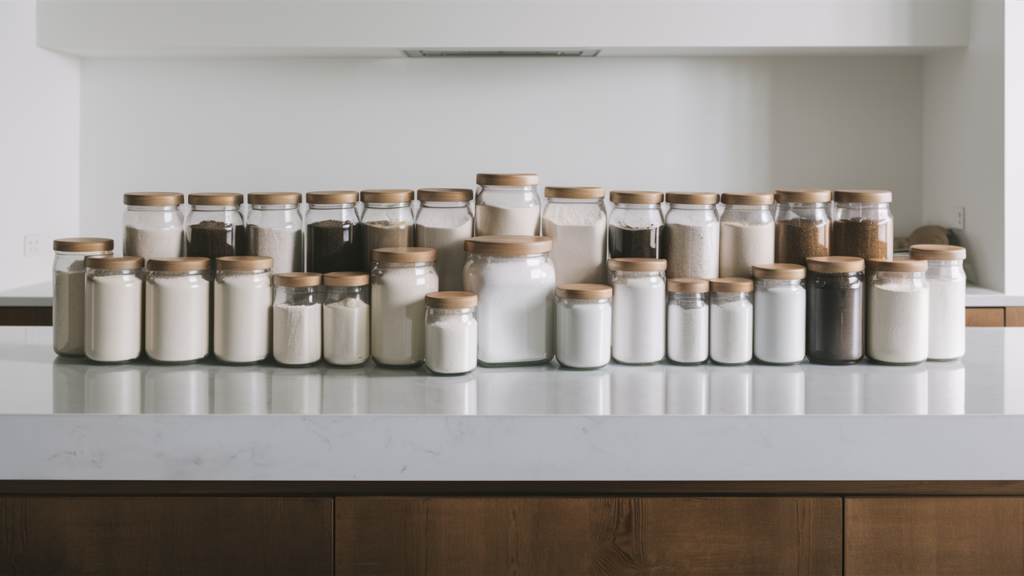
Flour comes in many varieties, each with unique properties and best uses in cooking and baking. Here’s an overview of some common types of flour:
- All-Purpose Flour: A versatile flour with moderate protein content (10-13%), suitable for most baking and cooking needs.
- Whole Wheat Flour: Made from the entire wheat kernel, it has a nutty flavor and denser texture. Best used in combination with all-purpose flour for everyday baking.
- Bread Flour: High in protein (12-15%), ideal for creating chewy textures in yeast breads, bagels, and pizza dough.
- Cake Flour: Highly refined with low protein content, perfect for producing fine, white textures in cakes and pastries.
- Self-Rising Flour: Contains added leavening agents and salt, convenient for quick breads and biscuits.
- Gluten-Free Flour: Made from alternative grains or nuts, suitable for those with gluten sensitivities or celiac disease.
- Semolina Flour: High-protein flour made from durum wheat, commonly used for pasta and some breads.
- Pastry Flour: With protein content between cake and all-purpose flour, it’s ideal for tender pie crusts and pastries.
All-Purpose Flour
All-purpose flour is a versatile, medium-gluten white flour designed for a wide range of baking applications. It is typically made from a blend of hard and soft wheat, with a protein content of around 10-12%. This balanced protein level makes it suitable for various baked goods, including breads, cakes, cookies, and pastries. All-purpose flour is indeed the same as plain flour, with the terms used interchangeably in different regions.
To measure all-purpose flour correctly, weighing is the most accurate method. One cup of all-purpose flour typically weighs about 125 grams, though this can vary slightly between brands. When using volume measurements, it’s best to spoon the flour into the measuring cup and level it off with a straight edge, rather than scooping directly from the bag.
For those seeking alternatives, cake flour can be used for softer baked goods, while bread flour is suitable for chewier textures. In gluten-free baking, a blend of rice flour, potato starch, and tapioca flour can often substitute for all-purpose flour. When substituting, it’s important to consider the protein content and adjust other ingredients accordingly to achieve the desired texture in your baked goods.
Self-Rising Flour
Self-rising flour is a convenient mixture of all-purpose flour, baking powder, and salt, designed to provide consistent leavening in baked goods. It typically contains about 8-9% protein, making it softer than all-purpose flour. To make self-rising flour at home, combine 1 cup of all-purpose flour with 1 1/2 teaspoons of baking powder and 1/4 teaspoon of salt. This flour is particularly popular in Southern U.S. cuisine and is ideal for quick breads, biscuits, pancakes, and some cakes. It simplifies baking by eliminating the need to measure leavening agents separately, ensuring consistent results in recipes specifically calling for self-rising flour.
Bread Flour
Bread flour is a high-protein flour specifically designed for yeast breads and other baked goods requiring strong gluten development. With a protein content ranging from 12-14%, bread flour contains more protein than all-purpose flour, which typically has 9-11% protein. This higher protein content allows bread flour to develop more gluten, resulting in chewy textures and higher rise in baked goods. Bread flour is ideal for yeast breads, pizza dough, bagels, pretzels, and other chewy baked products that benefit from strong gluten networks. Its ability to absorb more water and develop stronger gluten structures makes it particularly suitable for sourdough and other artisanal breads that require long fermentation times.
Almond Flour
Almond flour, made from finely ground blanched almonds, is a popular gluten-free alternative to wheat flour with numerous health benefits. It’s rich in vitamin E, magnesium, and dietary fiber, making it a nutritious choice for various diets. To make almond flour at home, blanch almonds in boiling water, remove the skins, dry them, and blend into a fine powder. Almond flour is naturally gluten-free, high in protein, and low in carbohydrates, making it suitable for keto and paleo diets. It can be used in a variety of recipes, including pancakes, cookies, banana bread, and as a breadcrumb substitute for frying. When baking with almond flour, note that it produces denser, moister goods due to its high fat content and lacks the rising properties of wheat flour.
Rice Flour
Rice flour is a versatile, gluten-free alternative to wheat flour made by grinding raw rice into a fine powder. It comes in several varieties, including white rice flour, brown rice flour, and glutinous rice flour, each with distinct properties and uses. White rice flour has a neutral flavor and smooth texture, making it suitable for a wide range of applications, from thickening soups and sauces to creating structure in baked goods. Brown rice flour offers a nuttier flavor and is often used in baking, while glutinous rice flour (despite its name, it contains no gluten) provides a chewy, elastic texture ideal for Asian desserts like mochi. Rice flour is a staple in Asian cuisine, used in dishes such as rice noodles, dumplings, and tempura batter. In gluten-free baking, it’s commonly used as part of flour blends for cakes, cookies, and bread, though it may require additional ingredients to mimic the properties of wheat flour.
Buckwheat Flour
Buckwheat flour is a nutritious, gluten-free alternative to wheat flour made from ground buckwheat seeds. Despite its name, buckwheat is not related to wheat but is actually a pseudocereal. This flour has a distinctive nutty, earthy flavor and a dark color that adds depth to baked goods. Buckwheat flour is rich in protein, dietary fiber, and essential nutrients like B vitamins, magnesium, and manganese. It’s commonly used in various cuisines worldwide, particularly in Eastern Europe and Asia. Buckwheat flour is ideal for making traditional dishes like Russian blini, Japanese soba noodles, and French galettes. In gluten-free baking, it’s often used for pancakes, quick breads, and cookies, typically combined with other gluten-free flours for optimal texture. When substituting in recipes, start by replacing 25-50% of the regular flour with buckwheat flour to achieve a balance of flavor and texture.
Semolina Flour
Semolina flour is a coarse, high-gluten flour made from hard durum wheat. It has a pale yellow color and a slightly sweet, nutty flavor. Semolina is prized for its high protein content, typically ranging from 12-13%, which contributes to its excellent gluten-forming properties. This makes it ideal for pasta-making, as it creates a dough that is less sticky, more elastic, and better able to hold its shape when cooked. Beyond pasta, semolina flour is commonly used in various breads, adding a crispy crust and dense, chewy texture. It’s also a key ingredient in couscous and is used in many Mediterranean, Middle Eastern, and North African dishes, including desserts like semolina cakes and puddings. In baking, semolina can be substituted for a portion of all-purpose flour to add flavor, texture, and a golden color to recipes.
00 Flour
00 flour, also known as doppio zero or double zero flour, is a finely ground Italian-style flour prized for its silky texture and versatility in pasta and pizza making. This flour is milled to the finest grade possible, resulting in a powder-like consistency that produces exceptionally smooth and pliable dough. With a protein content typically ranging from 10-12%, 00 flour strikes a balance between strength and tenderness, making it ideal for creating delicate pasta sheets and thin, crispy pizza crusts. Its fine grind allows for optimal hydration, resulting in pasta dough that is easy to work with and cooks to a tender yet slightly chewy texture. For pizza, 00 flour’s properties enable the formation of a thin, crisp crust with a light, airy interior. While traditionally used in Italian cuisine, 00 flour has gained popularity among home cooks and professional chefs worldwide for its superior performance in creating authentic pasta and pizza.
Cassava Flour
Cassava flour is a versatile, gluten-free alternative to wheat flour made from the whole cassava root. It has gained popularity due to its neutral flavor and fine, powdery texture that closely mimics wheat flour in many recipes. Cassava flour is naturally gluten-free, grain-free, and nut-free, making it suitable for various dietary restrictions including paleo, vegan, and autoimmune protocol diets. This flour is rich in carbohydrates and resistant starch, which may offer benefits for digestive health and insulin sensitivity. It can be used in a wide range of baked goods, including bread, pasta, tortillas, and pancakes, often as a 1:1 substitute for wheat flour in many recipes. However, due to its high absorbency, some recipes may require adjustments in liquid content. Cassava flour’s versatility, combined with its neutral taste and ability to brown and produce a crust in baking, makes it a popular choice for those seeking gluten-free alternatives.
Coconut Flour
Coconut flour is a gluten-free, high-fiber alternative made from dried, ground coconut meat. It has a light, airy texture and a subtle coconut flavor. This flour is exceptionally high in fiber, containing about 10 grams per 1/4 cup serving, making it beneficial for digestion and gut health. Coconut flour is also low in digestible carbohydrates, making it suitable for low-carb and keto diets. It’s commonly used in gluten-free baking for items like pancakes, muffins, and cakes, but requires special considerations due to its high absorbency. When baking with coconut flour, recipes typically use less flour and more liquid ingredients or eggs to achieve the desired texture. Its unique properties make it a valuable option for those with celiac disease, diabetes, or those seeking to increase their fiber intake.
Wheat Flour
Wheat flour comes in several varieties, each with distinct characteristics and nutritional profiles. Whole wheat flour is made from the entire wheat kernel, including the bran, germ, and endosperm, providing a higher fiber content and more nutrients than refined white flour. White flour, on the other hand, is made only from the endosperm, resulting in a finer texture and longer shelf life. Other types include semolina (coarsely ground durum wheat), and various grades of refined flour like all-purpose, bread, and pastry flour. Whole wheat flour is nutritionally superior, offering more fiber, vitamins, and minerals, while white flour is often enriched to replace some nutrients lost during processing. Whole wheat flour is ideal for hearty breads and baked goods, while white flour is versatile and commonly used in a wide range of recipes. The choice between wheat flour types depends on the desired texture, flavor, and nutritional content of the final product.
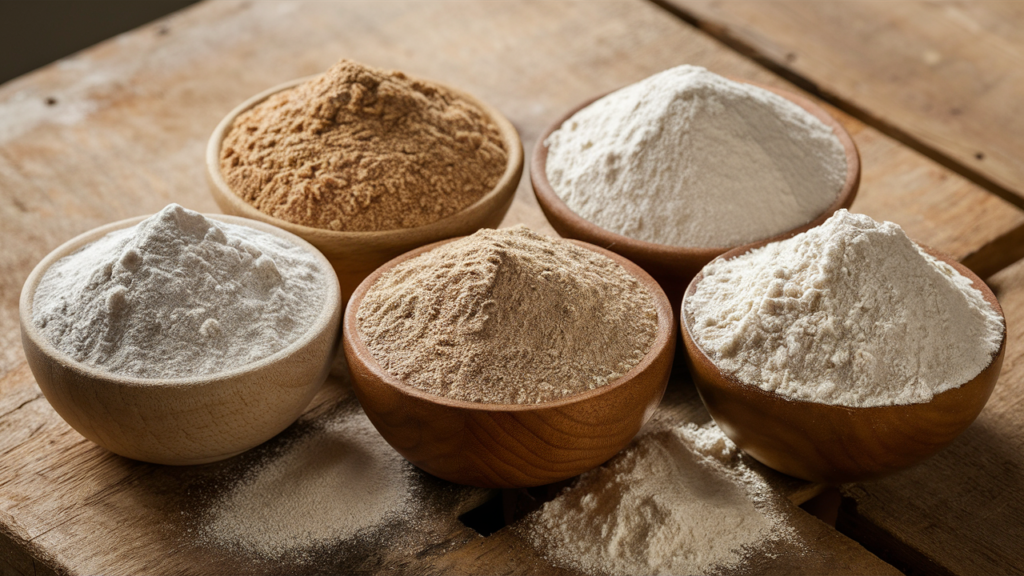
Flour Usage Guide
Different types of flour have unique properties that make them suitable for specific culinary applications. Here’s a concise overview of the best uses for various flour types:
| Flour Type | Best Uses |
|---|---|
| All-Purpose Flour | Versatile for most baking needs, including cookies, cakes, and breads |
| Self-Rising Flour | Quick breads, biscuits, pancakes, and some cakes |
| Bread Flour | Yeast breads, pizza dough, bagels, and pretzels |
| Almond Flour | Gluten-free baking, pancakes, cookies, and as a breadcrumb substitute |
| Rice Flour | Gluten-free baking, thickening sauces, and Asian dishes like noodles and dumplings |
| Buckwheat Flour | Pancakes, blini, soba noodles, and gluten-free baked goods |
| Semolina Flour | Pasta, couscous, and crusty breads |
| 00 Flour | Italian-style pasta and thin-crust pizzas |
| Cassava Flour | Gluten-free baking, tortillas, and as a wheat flour substitute in many recipes |
| Coconut Flour | Low-carb baking, pancakes, and as a thickener in sauces |
| Wheat Flour (Whole) | Hearty breads, muffins, and nutritious baked goods |
How to Store and Preserve Flour
Proper storage is crucial for maintaining flour quality and extending its shelf life. Below is a table summarizing the best storage practices for different types of flour:
| Storage Type | Recommendations |
|---|---|
| General Storage | All types of flour should be stored in airtight containers to protect against moisture, heat, and odors. |
| Short-term Storage | Refined flours like all-purpose can be kept in a cool, dry, dark place such as a pantry. |
| Whole Grain and Nut Flours | Should be stored in the freezer due to oils prone to rancidity. |
| Limited Freezer Space | Refrigeration is an alternative, but ensure the flour is in an airtight container to prevent moisture absorption. |
| Long-term Storage or Humid Climates | Even refined flours benefit from freezer storage. |
| Pest Prevention | Consider freezing flour for four days before transferring to long-term storage. |
| Labeling | Always label containers with the type of flour and purchase or expiration date to maintain a proper rotation system. |
Flour Substitutions
Here’s a concise guide to substitutions for various flour types:
All-Purpose Flour:
- Substitute: Equal parts bread flour or pastry flour
- Gluten-free option: 1 cup all-purpose flour = 1 cup gluten-free flour blend + 1/4 tsp xanthan gum
Whole Wheat Flour:
- Substitute: 7/8 cup all-purpose flour for 1 cup whole wheat flour
- For lighter texture: Use 50/50 mix of whole wheat and all-purpose flour
Bread Flour:
- Substitute: All-purpose flour (may result in less chewy texture)
- To mimic bread flour: Add 1 tsp vital wheat gluten per cup of all-purpose flour
Cake Flour:
- Substitute: 1 cup all-purpose flour minus 2 tbsp, plus 2 tbsp cornstarch
Self-Rising Flour:
- Substitute: 1 cup all-purpose flour + 1 1/2 tsp baking powder + 1/4 tsp salt
Gluten-Free Flour:
- Substitute: Commercial gluten-free flour blends or mix of rice flour, potato starch, and tapioca flour
Almond Flour:
- Substitute: Other nut flours or sunflower seed flour for nut-free option
Coconut Flour:
- Not easily substituted due to high absorbency; requires recipe adjustments
When substituting flours, consider protein content and moisture absorption to achieve desired texture in baked goods. Experiment with small batches to perfect ratios for your specific recipes.
Flour Exploration Takeaways
Flour is a versatile ingredient that comes in many varieties, each with unique properties suited for different culinary applications. All-purpose flour serves as a versatile base for most baking needs, while bread flour excels in creating chewy textures for yeast breads and pizza dough. Whole wheat flour offers nutritional benefits and a nutty flavor, ideal for hearty baked goods. Specialty flours like almond, rice, and coconut provide gluten-free alternatives with distinct flavors and textures. Experimenting with different flours can elevate your baking and cooking, offering new flavors, textures, and nutritional profiles. Don’t be afraid to try substituting or combining various flours in your favorite recipes to discover exciting culinary possibilities and expand your baking repertoire.
See also:
How to Reduce Food Waste When Cooking for One?
Baking Chart: Converting Pan Sizes to Cups and Milliliters
Resources
The UK and Ireland offer several valuable resources for those interested in flour and baking. Here’s a list of useful websites:
- Flour Advisory Bureau (FAB): Provides comprehensive information on flour, bread, and baking in the UK. Visit: https://fabflour.co.uk
- BakeryBits UK: Offers a wide range of premium quality baking flours. Explore their collection at: https://www.bakerybits.co.uk/flour
- UK Flour Millers: Provides information on the nutritional contribution of flour and industry regulations. Visit: https://www.ukflourmillers.org
- Cotswold Flour: Britain’s leading artisan flour mill, offering over 100 types of flour. Browse their collections at: https://cotswoldflour.com/collections
- Food a Fact of Life: An educational resource developed in conjunction with the Agricultural and Horticultural Development Board and the British Nutrition Foundation. It offers materials on the ‘field to fork’ cycle of wheat production and use. Access it at: https://www.foodafactoflife.org.uk

